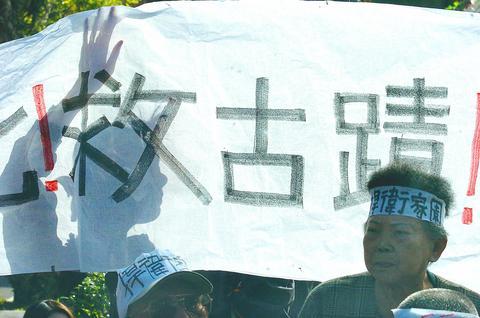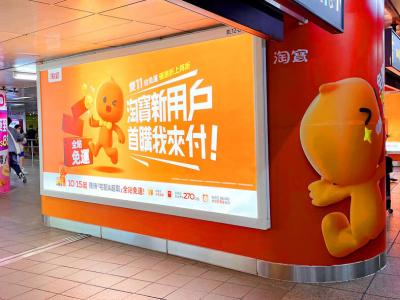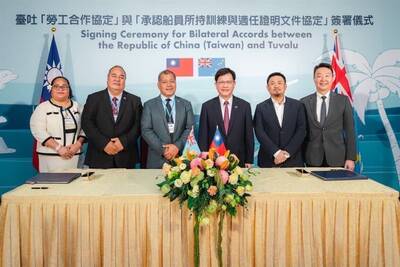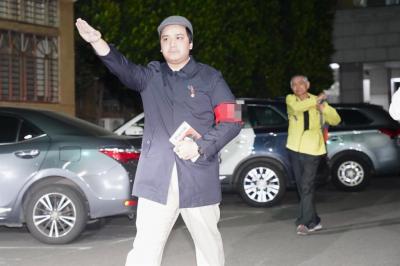Yesterday, on Human Rights Day, a group of aged lepers traveled with sticks and wheelchairs from Taiwan's sole public leper hospital "Happy Life Sanitarium" in Hsinchuang, Taipei County, to protest in front of the Executive Yuan. They were calling on the government to preserve the leper colony the infected have long called home.
Ten years ago, the health department of the now-defunct Province of Taiwan ceded the 17-hectare hillside property on which the leper colony is built to Taipei City for the construction of the Hsinchuang MRT line. Without the patients' consent or an assessment report on the site's value as a historical landmark, the 70-year-old sanitarium is to be demolished, and over 300 lepers are to be relocated to the newly-built Huilung Hospital (迴龍醫院).

PHOTO: GEORGE TSORNG, TAIPEI TIMES
Since then, the patients have undergone a decade-long odyssey of petitions to different government agencies -- the Taipei County Government, the Council for Cultural Affairs, the Legislative Yuan and finally the country's highest policy-making body, the Executive Yuan.
Building on the tensions of today's legislative election, the patients berated the incumbent Democratic Progressive Party (DPP) for ignoring the human rights values which the DPP vowed to champion.
"Premier Yu Shyi-kun said that he will take good care of the society's minority groups. A-bian also said that human rights are the foundation of our nation. Does forcing us to move respect our rights and show care for our lives?" the 72-year-old leper representative Tung Hsiang-ming (湯祥明) said, while holding a megaphone in his disfigured hands.
Before there was a cure, the Japanese regime sent lepers to Happy Life Sanitarium and would shoot anyone who tried to flee from the secluded world. Despite the fact the Happy Life Sanitarium was open to the public and stopped taking new patients when leprosy became treatable in the 1950s, most of the lepers -- long cut off from society and their families -- chose to stay and live out their lives in the sanitarium built under the Japanese regime.
As for the MRT project, the government planned to relocate over 300 patients to the 8-floor, modern Huilung Hospital.
"But a hospital is a place for a short-term stay, not for a life-long settlement," said the 75-year-old Huang Jing-liang (黃金涼). Huang was sent to the Sanitarium at the age of 14 and spent much of her childhood, adulthood and mid-years in the banyan-sheltered yards there.
Academics and doctors also consider the government's plan both unethical and disrespectful of Taiwan's history.
"Forcing them to move again is equal to a second quarantine, especially to those over 60 whose ability to adapt to a new environment is waning," said Dr. Hung Te-jen (
Although the government promised to preserve the Sanitarium's administration building, scholars contend that the cultural heritage will be lost once the wards are torn down and people are moved.
"What's the use of preserving the administration building but removing the people who are live witnesses to history?" asked Hsia Chu-joe (夏鑄九), professor at the National Taiwan University's Graduate Institute of Building and Planning.
"Once a historical building is removed from its site, it loses its vitality and every bit of it is mummified, like a specimen on display for curious onlookers. If the Happy Life Sanitarium is demolished, all that will be left of Taiwan's public health history will be debris," Hsia added.
The government has not guaranteed to preserve the sanitarium, although negotations are ongoing. Executive Yuan officials told leper representatives that government agencies will not dismantle the sanitarium before an alternative is agreed upon by both sides.
Earlier this year, the Taipei County Government said that the social cost of preserving the sanitarium was too great.
"To change the route of the Hsinchung MRT line in order to preserve the sanitarium will cost more than NT$10 billion and delay the completion date for more than three years," Taipei County Government's Bureau of Culture said in an official letter to the patients.

The Ministry of Economic Affairs has fined Taobao NT$1.2 million (US$36,912) for advertisements that exceed its approved business scope, requiring the Chinese e-commerce platform to make corrections in the first half of this year or its license may be revoked. Lawmakers have called for stricter enforcement of Chinese e-commerce platforms and measures to prevent China from laundering its goods through Taiwan in response to US President Donald Trump’s heavy tariffs on China. The Legislative Yuan’s Finance Committee met today to discuss policies to prevent China from dumping goods in Taiwan, inviting government agencies to report. Democratic Progressive Party Legislator Kuo Kuo-wen (郭國文) said

The Ministry of Economic Affairs has fined Taobao NT$1.2 million (US$36,900) for advertisements that exceeded its approved business scope and ordered the Chinese e-commerce platform to make corrections in the first half of this year or its license would be revoked. Lawmakers have called for stricter supervision of Chinese e-commerce platforms and more stringent measures to prevent China from laundering its goods through Taiwan as US President Donald Trump’s administration cracks down on origin laundering. The legislature’s Finance Committee yesterday met to discuss policies to prevent China from dumping goods in Taiwan, inviting government agencies to report on the matter. Democratic Progressive Party

Taiwan and its Pacific ally Tuvalu on Tuesday signed two accords aimed at facilitating bilateral cooperation on labor affairs, according to Taiwan’s Ministry of Foreign Affairs (MOFA). The governments inked two agreements in Taipei, witnessed by Foreign Minister Lin Chia-lung (林佳龍) and visiting Deputy Tuvaluan Prime Minister Panapasi Nelesone, MOFA said in a news release. According to MOFA, the agreements will facilitate cooperation on labor issues and allow the two sides to mutually recognize seafarers’ certificates and related training. Taiwan would also continue to collaborate with Tuvalu across various fields to promote economic prosperity as well as the well-being of their

Sung Chien-liang (宋建樑), who led efforts to recall Democratic Progressive Party (DPP) Legislator Lee Kun-cheng (李坤城), was released on bail of NT$80,000 today amid outcry over his decision to wear a Nazi armband to questioning the night before. Sung arrived at the New Taipei District Prosecutors’ Office for questioning in a recall petition forgery case last night wearing a red armband bearing a swastika, carrying a copy of Adolf Hitler’s Mein Kampf and giving a Nazi salute. Sung left the building at 1:15am without the armband and covering the book with his coat. Lee said today that this is a serious